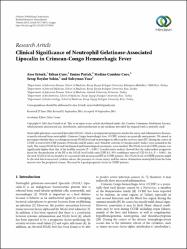| dc.contributor.author | Ertürk, Ayşe | |
| dc.contributor.author | Cüre, Erkan | |
| dc.contributor.author | Parlak, Emine | |
| dc.contributor.author | Cüre, Medine Cumhur | |
| dc.contributor.author | Şahin, Serap Baydur | |
| dc.contributor.author | Yüce, Süleyman | |
| dc.date.accessioned | 2020-12-19T19:58:36Z | |
| dc.date.available | 2020-12-19T19:58:36Z | |
| dc.date.issued | 2015 | |
| dc.identifier.citation | Erturk, A., Cure, E., Parlak, E., Cure, M.C., Sahin, S.B., Yuce, S. (2015). Clinical significance of neutrophil gelatinase-associated lipocalin in crimean-congo hemorrhagic fever. Biomed Research International, 2015. https://doi.org/10.1155/2015/374010 | |
| dc.identifier.issn | 2314-6133 | |
| dc.identifier.issn | 2314-6141 | |
| dc.identifier.uri | https://doi.org/10.1155/2015/374010 | |
| dc.identifier.uri | https://hdl.handle.net/11436/2990 | |
| dc.description | Cure, Medine Cumhur/0000-0001-9253-6459; cure, erkan/0000-0001-7807-135X; ERTURK, AYSE/0000-0001-6413-9165 | en_US |
| dc.description | WOS: 000349080400001 | en_US |
| dc.description | PubMed: 25685783 | en_US |
| dc.description.abstract | Neutrophil gelatinase-associated lipocalin (NGAL), which is an important prognostic marker for sepsis and inflammatory diseases, is mostly released from neutrophils. Crimean-Congo hemorrhagic fever (CCHF) patients are generally neutropenic. We aimed to investigatewhether there is a change in serum NGAL level and to investigate its effect on the recovery time (RT) during the course of CCHF. A total of 40 CCHF patients (19 females and 21 males) and 34 healthy controls (17 females and 17 males) were included in the study. the serum NGAL level and biochemical and hematological parameters were checked. the NGAL level of CCHF patients was significantly higher than that of the healthy controls (P < 0.001). A multivariate analysis showed that the independent prognostic factor for the prediction of the RT is the NGAL level (odds ratio [OR] 0.3, 95% confidence interval [Cl] 0.1-0.4, P < 0.001). An elevated NGAL level was found to be associated with an increased RT in CCHF patients. the NGAL levels of CHHF patients might be elevated due to increased cytokine release, the presence of a tissue injury, and the release of immature neutrophils from the bone marrow into the peripheral stream. This may be a good prognostic factor in CHHF patients. | en_US |
| dc.language.iso | eng | en_US |
| dc.publisher | Hindawi Ltd | en_US |
| dc.rights | info:eu-repo/semantics/openAccess | en_US |
| dc.subject | NGAL | en_US |
| dc.subject | Hemophagocytosis | en_US |
| dc.subject | Pathogenesis | en_US |
| dc.subject | Sepsis | en_US |
| dc.subject | Alpha | en_US |
| dc.title | Clinical significance of neutrophil gelatinase-associated lipocalin in crimean-congo hemorrhagic fever | en_US |
| dc.type | article | en_US |
| dc.contributor.department | RTEÜ, Tıp Fakültesi, Dahili Tıp Bilimleri Bölümü | en_US |
| dc.contributor.institutionauthor | Ertürk, Ayşe | |
| dc.contributor.institutionauthor | Cüre, Erkan | |
| dc.contributor.institutionauthor | Cüre, Medine Cumhur | |
| dc.contributor.institutionauthor | Şahin, Serap Baydur | |
| dc.contributor.institutionauthor | Yüce, Süleyman | |
| dc.identifier.doi | 10.1155/2015/374010 | |
| dc.identifier.volume | 2015 | en_US |
| dc.ri.edit | oa | en_US |
| dc.relation.journal | Biomed Research International | en_US |
| dc.relation.publicationcategory | Makale - Uluslararası Hakemli Dergi - Kurum Öğretim Elemanı | en_US |


















